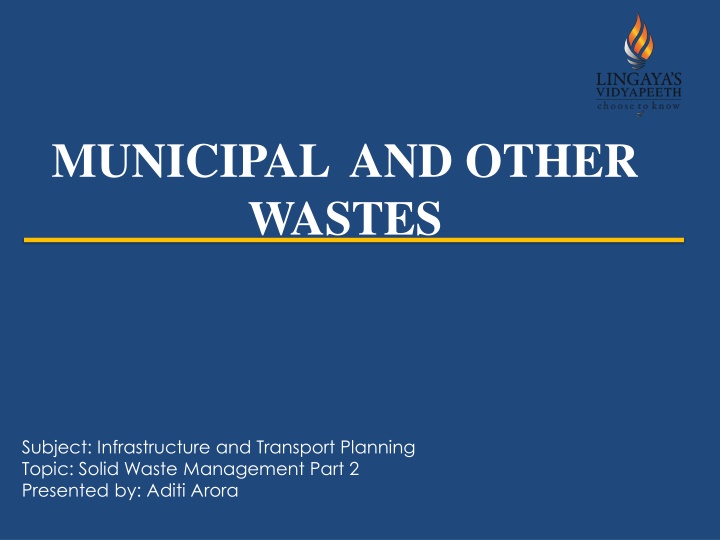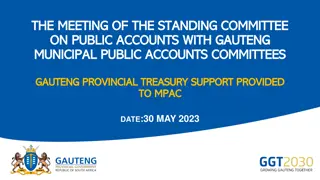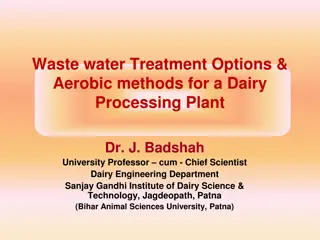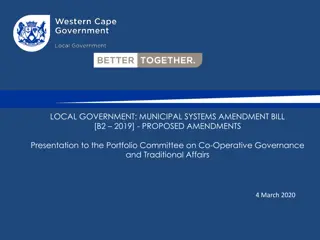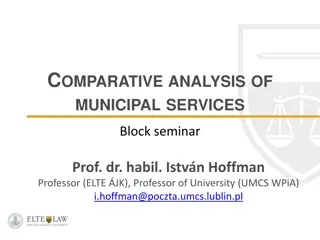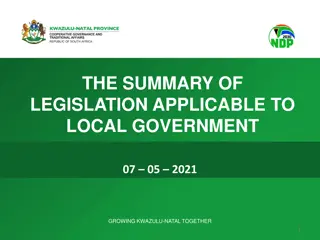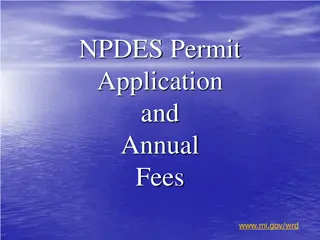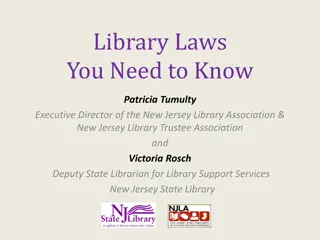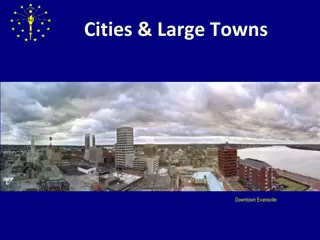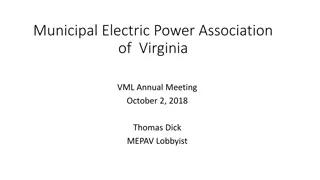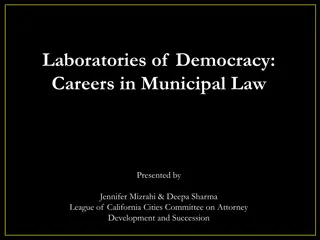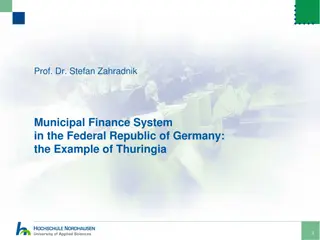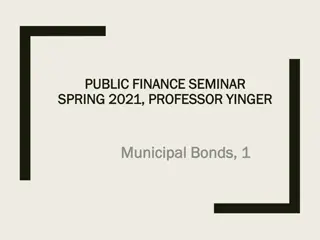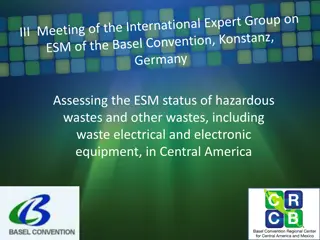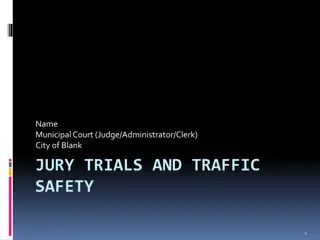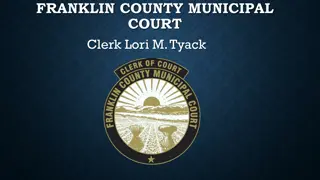MUNICIPAL AND OTHER WASTES
Sanitary landfills, composting, incineration, gasification, and pyrolysis are explored in solid waste management. Each method's process and suitability based on waste composition are discussed, providing insights into efficient waste disposal practices.
Download Presentation

Please find below an Image/Link to download the presentation.
The content on the website is provided AS IS for your information and personal use only. It may not be sold, licensed, or shared on other websites without obtaining consent from the author.If you encounter any issues during the download, it is possible that the publisher has removed the file from their server.
You are allowed to download the files provided on this website for personal or commercial use, subject to the condition that they are used lawfully. All files are the property of their respective owners.
The content on the website is provided AS IS for your information and personal use only. It may not be sold, licensed, or shared on other websites without obtaining consent from the author.
E N D
Presentation Transcript
MUNICIPAL AND OTHER WASTES Subject: Infrastructure and Transport Planning Topic: Solid Waste Management Part 2 Presented by: Aditi Arora
Sanitary Landfill: This is a fully engineered disposal option in which the selected site for disposal is carefully observed and kept at check. Operators of sanitary landfills can therby control the effects of lechate (polluted discharge from a landfill) and gas production. This method is suitable where Land is available at an affordable price There is sufficient workforce Financial assistance is assured to maintain the site
Composting: Works under the biological process of decomposition Micro-organisms under controlled conditions of ventilation, temperature and moisture content convert the organic portion of solid waste into a humus like substance called compost. Initially The end product is stable, odour free and a soil conditioner Suitable when there is a considerable portion of bio-degradable waste Small scale composting practices can be carried out at the household level Finally
Incineration: Controlled burning of wastes at a high temperature(1200 C-1500 C) Sterilizes and stabilizes the waste in addition to decreasing volume Combustible material like paper and plastics gets converted into CO2 and ash Can be used when the waste composition is highly combustible Appropriate technology, skilled workforce and infrastructure are required to operate and maintain the plant Process of Incineration
Gasification: Partial combustion of carbonaceous material at around 1000 C A gas is formed comprising of CO2, CO, N2, H2, H2O and CH4 which can be used as fuel Refuse Derived Fuel (RDF): Combustible part of raw waste is separated for burning as fuel Various physical processes such as screening and magnetic separation are used to separate the combustible material from the other wastes
Pyrolysis: Thermal degradation of carbonaceous material to gaseous, liquid and solid fraction in the absence of oxygen. This occurs at a temperature between 200 -900 C The product is a gas of very high calorific value Pyrolysis Chamber
WEALTH FROM WASTE ECONOMIC BENEFITS Reduction in quantum of waste by diverting it to recycling and other processing unit reduces the landfill costs; Better managed waste management services indicate better value at same cost; An effective waste management implies reduce, reuse and recycle waste matter leading to introduction of more and more of waste matter into the value chain leading to economic benefits; and Waste management being a labour intensive activity, it helps in employment generation. Introduction of rag pickers into formalized waste collection and segregation process is a win- win scenario for implementers. Source: Toolkit for Solid Waste Management JNNURM
RECLAIMING EXISTING DUMP SITES THROUGH LANDFILL CAPPING Site reclamation is a process of reintroducing an existing waste disposal site (or a dump site) into useful land resource through restructuring, stabilizing and covering of the openly disposed waste through engineered land capping techniques. Source: Toolkit for Solid Waste Management JNNURM LANDFILL GAS EXTRACTION The waste deposited in a landfill gets subjected, over a period of time, to anaerobic conditions. This leads to landfill gas production containing about 45-55% methane. This methane can be recovered through a network of pipes and utilised as a source of energy. Landfill gas extraction systems adds to Climate Change initiatives as it helps reduce Green House Gas emissions through avoidance of landfill gas (mainly comprising of methane) into the atmosphere. Source: Toolkit for Solid Waste Management JNNURM EXAMPLE - CONVERTING MUNICIPAL WASTE TO WEALTH (Article in The Indian Express www.archive.indianexpress.com) Example of Gorai in the western suburbs of Mumbai. 2.3 million tonnes of garbage in an open dump with an average height of 26m converted to beautiful green grounds covering an area close to 48 acres. 1200 tonnes of garbage was being dumped daily.
The site was being used for dumping since 1972 and had become a huge public health hazard. In March 2007 the dumpsite was shut by the directive of court. The Municipal Corporation of Greater Mumbai (MCGM) entered into a PPP for the scientific closure of this dumpsite. MGCM earns carbon credits for the capture and combustion of methane gas from Gorai. A tone of methane is equivalent to 21 tonnes of carbon in its global warming potential. Gorai is the first dumpsite closure project in India to be registered at the United Nations Framework Convention on Climate Change (UNFCCC). MGCM has already received a carbon advance of Rs. 25 crore against the future delivery of carbon credits from the Asian Development Bank, and the total carbon credit earnings are expected to be about Rs. 72 crore (higher than the total capital cost of the project). (A carbon credit is a generic term for any tradable certificate or permit representing the right to emit one tonne of carbon dioxide or another greenhouse gas with a carbon dioxide equivalent equivalent to 1 tonne of carbon dioxide. Carbon credits and carbon markets are a component of national and international attempts to mitigate the growth in concentration of greenhouse gases.) MCGM is also in discussions with a leading energy company to set up a 2MW power plant at the site to convert the methane to energy, further enhancing the revenue capability of the project.
OTHER REVENUE GENERATING SOURCES (Article in The Indian Express www.archive.indianexpress.com) Composting: Preparing organic manure by microbial decomposition of organic matter under aerobic conditions. Biogas from organic waste which can be used to power electricity generators. Construction debris waste can be used in pavement blocks. Refuse derived fuel (RDF) technology produces energy by burning waste. (Incineration of pellets) [Source: infochnage.india.org]
NORMS AND STANDARDS According to Municipal Solid Waste (MSW) Rules 2000 MSW includes commercial and residential wastes generated in a municipal or notified areas in either solid or semi-solid form excluding industrial hazardous wastes but including treated bio-medical wastes. The following table indicates the waste generation per capita per day for estimation and forecast of waste generation for future for planning purposes. Table: Waste generation per capita per day LAND USE TYPE ESTIMATED WASTE GENERATION 0.3 to 0.6 kg/cap/day 0.1 to 0.2 kg/cap/day 0.05 to 0.2 kg/cap/day 0.05 to 0.2 kg/cap/day Residential refuse Commercial refuse Street sweepings Institutional refuse Source: URDPFI Guidelines, 2014
SERVICE LEVEL BENCHMARKS Ministry of Urban Development (MoUD) has initiated an exercise to define Service Level Benchmarks (SLBs). It is suggested that SLB should be considered as benchmark for measuring, reporting and monitoring the performance and comparing inter and intra city level infrastructure. SERVICE CRITERIA UNIT SERVICE LEVEL BENCHMAR K HOUSEHOLD LEVEL COVERAGE OF SOLID WASTE MANAGEMENT SERVICE As % of households and establishments that are covered by daily door-step collection system. As % of total waste collected by ULB and authorized service providers against waste generated within (excluding the waste recycled through rag pickers). As % of households and establishments that segregate their waste. 100% EFFICIENCY OF COLLECTION OF MUNICIPAL SOLID WASTE 100% the project area SOLID WASTE MANAGEMENT EXTENT OF SEGREGATION OF MUNICIPAL SOLID WASTE 100% EXTENT OF MUNICIPAL SOLID WASTE RECOVERED OR RECYCLED Quantum of waste collected, which is either recycled or Processed, expressed as %. As % of waste disposed in a sanitary landfill site against total quantum of waste disposed in landfills and dump sites. 80% EXTENT OF SCIENTIFIC DISPOSAL OF MUNICIPAL SOLID WASTE 100% Source: URDPFI Guidelines, 2014 & Toolkit for Solid Waste Management JNNURM
SERVICE CRITERIA UNIT SERVICE LEVEL BENCHMARK 100% Expressed as % recovery of all operating expenses related to SWM Services that the ULB is able to meet operating revenues of sources related exclusively to SWM. As a % of total number of SWM related resolved against total number of SWM complaints received within 24 hrs time period. Efficiency in collection is defined as - Current year revenues collected, expressed as a % of the Total operating revenues, corresponding time period. EXTENT OF COST RECOVERY IN SOLID WASTE MANAGEMENT SERVICE from the 80% complaints EFFICIENCY OF REDRESSAL OF CUSTOMER COMPLAINTS SOLID WASTE MANAGEMENT 90% EFFICIENCY IN COLLECTION OF USER CHARGES for the Source: URDPFI Guidelines, 2014 & Toolkit for Solid Waste Management JNNURM
Institutional arrangements AT CENTRAL LEVEL Function: Central Ministries provide assistance (a Cell may be designated) to the States in terms of technical assistance(usually through guidelines) Selection of appropriate technologies for waste processing and disposal enabling them to take decisions take initiatives to facilitate implementation of MSW rules. (C.P.H.E.E.O Central Public Health and Environmental Engineer Organisation manual ) :infrastructure Needs clearance from central pollution control board : Environment Appraisal Committee (EAC) environmental clearance under the Environmental Impact Assessment (EIA) Notification 2006 ,State Environment Impact Assessment Authority (SEIAA). :consider to set-up waste-to-energy demo projects. :Department of Science and Technology (DST): technology innovation and Ministry of Urban Development (MoUD), CPCB MoEF(Ministry of Environment and Forest): Ministry of Non-Conventional Energy Sources(MNES) Ministry of Agriculture (MoA) Ministry of New and Renewable Energy (MNRE) Technology Information, Forecasting and Assessment Council (TIFAC):
Institutional arrangements State level: similar type of Group set-up to assist local bodies. Evolve Plans and Policy to provide technological and financial assistance to the local bodies. The Secretary, UD deptt of the respective state government :enforcement of the provisions in metropolitan cities. A District Magistrate of the concerned district :the enforcement of these provisions within the territorial limit . Municipal authority Implementation + development of required infrastructure Ensures that municipal solid wastes to be handed as per rules. Seeking authorisation from SPCB(state Pollution Control Board) Furnishing annual report. MCD has privatized collection of municipal solid waste Regional MSW Development Approach: where two or more ULB s work together. A Guidance Note Municipal Solid Waste Management on Regional Basis. Integrated composting, Regional Landfills.
Financing organisations Coordination between agencies in MSW Planning Capital Expenditure Funding Grants from JNNURM Fund Subsidies from MNRE PPP as a source of Capital Funding Other National / State Level Infrastructure Funds Loans from Financial Institution, Bank Loans funds under 13th Finance Commission AIRPORT AUTHORITY REVENUE DEPARTME NT ELECTRICITY DEPARTME NT COORDINAT ION WASTE MANAGEM ENT Meeting Operation & Maintenence Expenses Private Party Investment in Operation & Maintenence Institutional Finance Bank Loans Role of Resident Welfare Associations (RWAs), Non-governmental Organizations (NGOs), and Community Based Organizations (CBO) community is keen to manage its own waste help in door to-door collection and source segregation of waste POLLUTION CNTROL DEPARTME NT TRAFFIC DEPARTME NT IRRIGATION DEPARTME NT GROUND WATER
Planning Provisions Dhalaos including facility of segregation of biodegradable and recyclable solid waste should be provided. 1 unit = 200 sqmt. for 10000 population. ( as / master plan Delhi 2021 ) Reduce disposal of waste in landfills by proper segregation of waste at source, post-occupancy. Develop a waste management plan for the project and identify methods to segregate and efficiently dispose waste. recyclable waste such as organic at source of generation. Place colour coded waste bins in all public areas to collect waste, paper, glass, plastic, cardboard, metal, e-waste, etc., commercial buildings for proper collection Insist on segregation of waste in residential and and disposal ( IGBC Green Townships Rating System ) Sustainable approach for solid waste management is 3 R 1. Reduce 2. Recycle 3. Reuse
Municipal Solid Waste (Management & Handling)Rules, 2000 (MSW Rules) These rules are applicable to every municipal authority responsible for collection, segregation, storage, transportation, processing and disposal of municipal solids. These rules provide specifications : Specifications relating to collection, segregation, storage, transportation, processing and disposal of municipal solid waste Specifications for landfilling indicating; site selection, facilities at the site, specifications for landfilling, Pollution prevention, water quality monitoring, ambient air quality monitoring, Plantation at landfill site, closure of landfill site and post care. Specifications for landfill Sites: (a) Site selection: The site selection shall be done based on examination of environmental issues. The landfill facility shall be nearby waste processing plant or an integral part of it. The landfill site shall be designed for 20-25 years. The proposed landfill site should be away from habitation clusters, forest areas, water bodies, monuments, national Parks, Wetlands and places of important cultural, historical or religious interest. Approval shall be taken from the concerned authorities in case the landfill site is located within 20 km from the airport/airbase.
(b) Facilities at Site: The landfill shall be fenced with proper gate at entrance for monitoring incoming wastes/vehicles, to prevent entry of cattle, to keep record movement of vehicles and wastes, etc. Also, provision of weigh-bridge may be made for assessing quantum of wastes. Drinking water and other sanitary facilities and other safety measures including health check up shall be provided to workers. (c) Specification for land filling: Waste subjected to landfilling shall be compacted in thin layers to achieve maximum capacity of landfill. The disposed wastes shall be covered immediately/at the end of working day with 10 cm of soil. Waste subjected to landfilling shall be compacted in thin layers to achieve maximum capacity of landfill Proper drainage to be provided to divert run-off water from the active landfill cell. Also, provision of weigh-bridge may be made for assessing quantum of wastes. Drinking water and other sanitary facilities and other safety measures including health check up shall be provided to workers. (d) Pollution Prevention: The water table should be at least 2 m below the base clay or amended soil barrier layer. Provision of leachate collection and treatment shall be made as per standards .
(e)Water quality monitoring: Ground water quality to be monitored within 50 m periphery of landfill site. Ground water quality data to be generated before construction of landfill site for future reference. (f) Ambient air quality monitoring: Installation of landfill gas control system including gas collection system shall be made at landfill site to minimize Pollution. prevent off-site migration of gases and to protect vegetation planted on rehabilitated landfill surface. (g) Plantation at Landfill site: A vegetative cover shall be provided over completed site as follows; The roots of the plants grown should not penetrate more than 30 cm, The density of plantation shall be sufficient to minimize soil erosion. (h)Closure of landfill site and post- care: Maintaining integrity and effectiveness of final cover and repair required, Efficiency of leachate collection system. Ground water quality need to check and action required to improve if deficiency found.
Maintenance and operation of gas collection system to meet the standards. The closed landfill may be used for human settlement after 15 years of post-closure care by ensuring gaseous emission and leachate compliance. (i) Special provisions for hilly areas: Cities/ towns located in hilly areas shall adopt location specific methods of disposal with permission of concerned state pollution control board ( SPCB ).
Plan showing Gas Collection Vents Section Of Land Fill Plan showing surface water Drains
Management Issues Efficient service delivery (collection and removal of garbage, construction and demolition debris and other types of waste, street sweeping etc. leading to clean surroundings and feeling of well being amongst the citizens). Strategy for reducing land requirement. Appropriate disposal of waste in conformity with the applicable rules and most importantly. Lack of public participation. Some municipalities may have identified disposal sites but still only few may actively manage them; further municipalities are not equipped to deal with the problems associated with it, such as issues of privatization and monitoring of the contract. Accessibility of a disposal site especially its distance from town, an important factor in site selection. Successful programme needs effective political and govt. support. In the absence of adequate data or the means of collecting/acquiring it, officials often struggle to plan a safe and economically viable disposal option.
